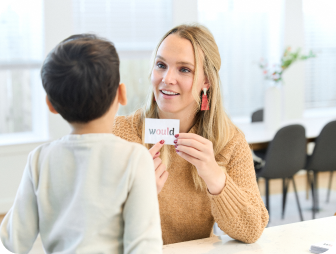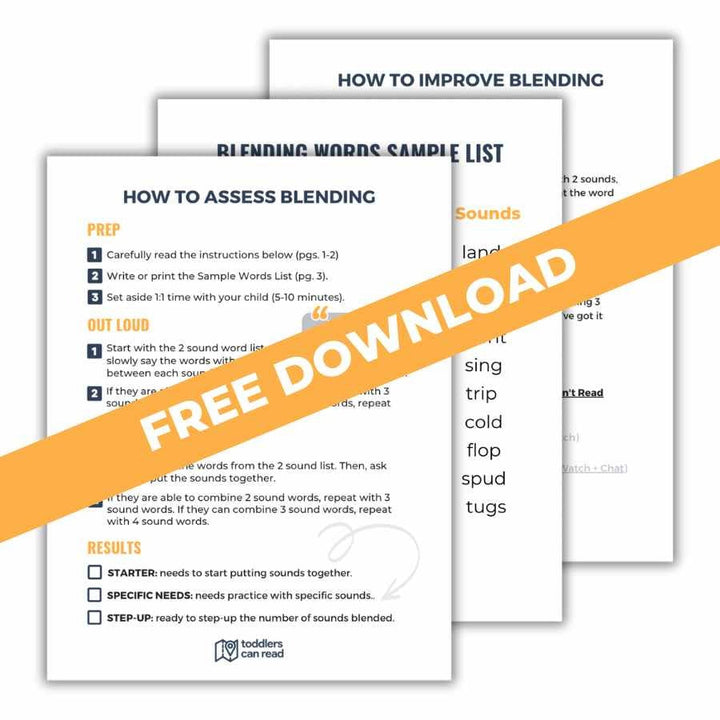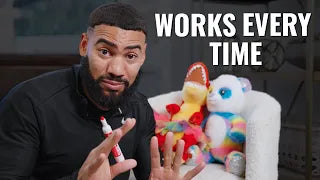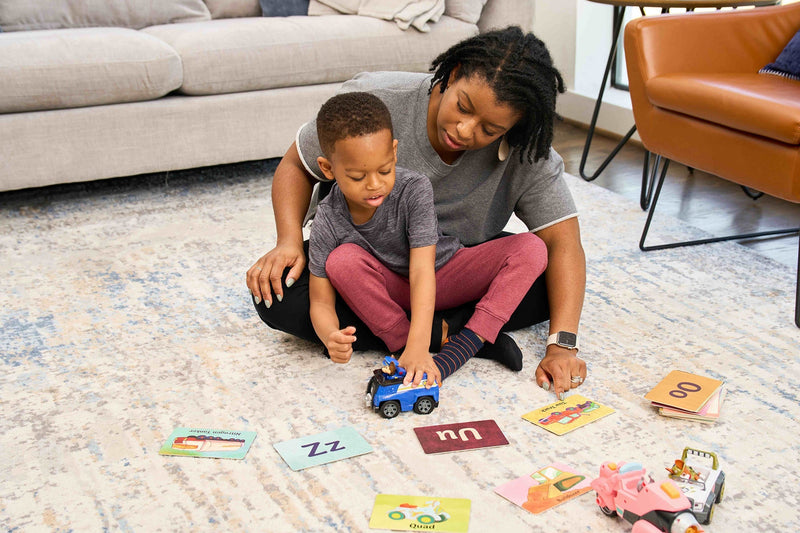Thanks to research about early literacy and learning research, we’ve come to understand four critical points about how to best support kids’ reading journey.
- Kids have to be intentionally taught to read. They don’t just “pick it up” through exposure.
- Most kids learn to read faster and better when they’re taught using phonics.
- No matter what the subject, kids learn best through play.
- Screen time doesn’t support learning outcomes, especially for little kids.
At first glance, that list seems do-able: Teach phonics, through play, without screens. Got it! But the “how” is what trips people up. After all, most parents aren’t reading teachers. And when they go looking for resources to help them, they pretty quickly discover that most reading resources miss the mark when it comes to phonics, play, and/or screen time.
Enter the Lovevery Reading Skill Set.
Lovevery Reading Skill Set or Toddlers Can Read?
Grounded in reading science, Lovevery’s three-part Reading Skill Set checks all those boxes: Teach phonics, through play, without screens.
Now, before I go any further, let me address the elephant in the room. Toddlers Can Read also has a three-part program to help parents teach their kids to read. So why am I writing about Lovevery’s instead of our own? In part, because I’m part of the Lovevery team. More importantly, though, I want you to have the information you need to get the most benefit from whatever program you choose.
Although Toddlers Can Read and Lovevery products work toward the same goal, the approaches aren’t exactly the same. (And that’s good, because families aren’t exactly the same either.) For more on that, read my honest review of the Lovevery Reading Skill Set, including tips to help you decide if it’s a good fit for you.
For today, though, let’s take a tour of the Lovevery Reading Skill Set Part 1, Sounds to Reading. Along the way, I’ll offer some suggestions for how to use the materials with your child.
Purpose
To read independently, kids need to be able to decode (sound out) words. That skill requires phonological awareness, which is the ability to hear and “play with” the many different parts of spoken words. One of those parts is the phoneme: the smallest unit of sounds.
When kids are able to hear phonemes, they can begin associating them with their corresponding letters or groups of letters. Building that knowledge is what Part 1 of the Lovevery Reading Skill Set is designed to do.
Through both independent and cooperative play (with you!), your child will master two skill groups: isolating sounds and learning letter sounds. By the end of Part 1, they’ll be doing their first spelling and reading.
Age and Stage
Part 1 of Lovevery’s Reading Skill Set works on skills most commonly taught in Pre-Kindergarten and Kindergarten. If your child has already mastered the letter sounds, have a look at Part 2 of the Reading Skill Set.
Games, Activities, and Books
Part 1 of the Reading Skill Set includes 9 skill-based games and activities and 7 confidence-boosting books. You also receive a Play Guide and access to an online portal, which means there’s no parent expertise required.
Tip: Each game and activity is packaged individually inside the Reading Skill Set shipping box. When you open the box, you’ll find instructions for what pieces to open first and what to leave boxed up until your child’s ready for them. Following those suggestions will help prevent sensory overload (yours and your kid’s).
Play Guide

The Play Guide explains what skills your child will learn and why those skills are important. It also offers ideas to help keep learning time fun and effective.
Tip: Spend 20-30 minutes reading through the Play Guide and getting familiar with the games and activities before you invite your child to engage with you.
Compound Word Pairs

Goal: Begin to isolate sounds.
Play: Match pairs of picture cards together to see how some words are made of two smaller words, like basketball, starfish, and sunflower.
Tip: Help your child with the first 3-4 words, and then let them explore on their own. This activity is self-correcting!
Syllable Race Game

Goal: Learn how to break longer words into easier-to-read parts.
Play: Draw a picture card, then move your dog-shaped game piece one space for each syllable in the word, tapping in each square for a nice auditory cue.
Tip: The Syllable Race Game also supports social-emotional learning through taking turns. Fair warning: The game includes a skip-your-turn card. Give your kid a heads-up about that before you start the game.
Rhyming Leaves Game

Goal: Identify and create rhymes.
Play: Choose a green leaf and invite your child to do the same. Then, say each of your words at the same time. If the two words rhyme, add the leaves to the tree. If they don’t, try again with two different leaves. For a more advanced version, choose an orange leaf and ask your child to think of a word that rhymes with it.
Tip: Made-up words are acceptable! Right now, your child’s goal is to understand rhyming, not grow their vocabulary.
Follow the Sound Maze

Goal: Learn how to isolate the first and last sounds of words, which are often the trickiest.
Play: Place a blue card into the holder. Invite your child to open a window and identify the first sound of the word. Then, invite them to move through the maze by finding words that have that same first sound. To practice last letter sounds, use the pink cards.
Tip: When your child understands how Follow the Sound Maze works, let them play independently. They can check their work at the end of the maze by lifting the flap at the bottom.
Movable Alphabet

You’ll use this piece of the Reading Skill Set in conjunction with other games and activities included in Part 1.
The ABCs with Mr. Z

Goal: Learn each letter’s most common sound.
Play: Snuggle up with your child and read the book to them. On each page, see how many images they can identify that begin with the same letter.
Tip: When kids are first learning their letter sounds, it can be helpful to focus on just 3-4 sounds a time. Start with these sounds, and try using flashcards for more focused practice.
Wooden Letter Sound Blocks

Goal: Learn letter sounds.
Play: Choose four blocks. Ask your child to select one of the four blocks, place it into the base, and identify the starting sound of the image. Next, ask them to pick up a second block, find another image that begins with that same letter sound, and place it into the base, too. When your child has placed all four blocks into the base, they’ll see the lower case letter associated with the sound they’ve been exploring.
Tip: As your child’s confidence grows, use more and more blocks to add to the challenge.
Skill Tokens

Practicing skills in the same way over and over can be really boring. In combination with the Wooden Letter Sound Blocks, the Skill Tokens offer a new way to practice and master skills.
Letter Case Beehive

Goal: Learn the uppercase form of each letter.
Play: For this game, you’ll need your Movable Alphabet and a good bit of floor space. Take turns rolling the die. When one of you rolls a flower, turn over one flower card, add it to the honeycomb you’re building, and ask your child to find the lowercase version of that letter. If you roll a bear, move the bear one space closer to the honeycomb. Keep playing until the honeycomb is complete or the bear reaches the honeycomb.
Tip: Many parents have success teaching lowercase and uppercase letters at the same time. If your child seems to be having trouble, Letter Case Beehive is a fun way to grow their confidence.
Spell & Check Slider

Goal: Learn to spell and blend 3- to 5-letter words.
Play: Ask your child to choose a tile and place it on the bottom left of the slider. Invite them to say the word and then break it into its three sounds. Next, encourage them to find and place the Movable Alphabet letters to spell the word. Finally, ask them to slide the tile to the right to reveal the correct spelling of the word.
Tip: Before you break out this activity, assess your child’s letter sound knowledge. It’s important to have that foundational skill mastered before moving on to spelling.
Wordless Book

Goal: Become familiar with story structure.
Play: Using clues from the images in the book, invite your child to tell the story of what’s happening.
Tip: Ask open-ended questions as your child tells their story to stoke their imagination and encourage creativity.
Turn-Taking Book Series

Goal: Practice letter sound blending skills.
Play: Take turns reading together and watch your child’s confidence build as they read the sections written especially for them.
Tip: Resist the temptation to jump in and “rescue” your child when they seem stuck. For example, instead of sounding out a word for them, guide them to use the skills they’ve learned so far. It might sound like this: “I see you’re having a little trouble with this word. Let’s break it down. Remind me what sound this letter makes.”
The Science
If you’re a parent who likes to nerd-out on reading science and understand the why behind the games and activities, consider the Toddlers Can Read Learning Sounds online course as a companion to Part 1 of the Lovevery Reading Skill Set.
Learning Sounds is also an ideal alternative for parents with kids younger than 3 (because of the small pieces in the Reading Skill Set), those with older kids (ages 8 and up), or those who prefer a more direct instruction approach.
As always, if we can be of any help, we’re here for you! Reach out to support@toddlersread.com.









